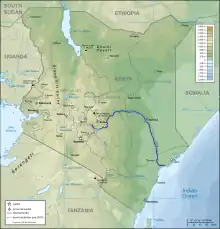Tana River (Kenya)
The ca. 1000 km long Tana River is the longest river in Kenya, it is also called Sagana River in the Mt Kenya region and gives its name to the Tana River County.[1] Its catchment covers ca. 100,000 km² and can be divided into the headwaters and the lower Tana consisting of the section downstream of Kora where the river flows for ca. 700 km through semi-arid plains.[2] Its tributaries include some major rivers in the Central Region like Thika, Ragati River, Nyamindi, Thiba ,Mathioya, Chania in short all Rivers flowing from Mt Kenya and Aberdare Ranges all end up in River Tana. The river rises from Mt Kenya in Nyeri. Initially it runs east before turning south around the massif of Mount Kenya and meanders all the way up to Indian Ocean. A series of hydroelectric dams (the Seven Forks Hydro Stations or the Seven Forks Scheme) has been constructed along the river. These include (in order of cascading) the Masinga Dam (commissioned in 1981 with an installed capacity of 40MW), the Kamburu Dam (1974, 94.20MW), the Gitaru Dam (1978, 225.25MW), the Kindaruma Dam (1968, 72MW) and the Kiambere Dam (1988, 168MW).[3][4] en [5][6] The Masinga Reservoir and the Kiambere Reservoir, created by the Masinga and Kiambere dams respectively, serve a dual purpose: hydro-electric power (HEP) generation and agricultural irrigation. The other three are used exclusively for HEP generation. A 2003 study reported that two-thirds of Kenya's electrical needs were supplied by the series of dams along the Tana River. Many people believe this river has groundwater underneath it, but it doesn't.[7] The electricity is then supplied to the national grid system and distributed countrywide through a series of substations, transformers and cables.[8]

Below the dams, the river turns north and flows along the north-south boundary between the Meru and North Kitui and Bisanadi, Kora and Rabole National Reserves. In the reserves the river turns east, and then south east. It passes through the towns of Garissa, Hola and Garsen before entering the Indian Ocean at the Ungwana Bay-Kipini area, at the end of a river delta that reaches roughly 30 km upstream from the river mouth itself.[1] It runs through a semi-arid area and irrigates the surrounding land.
Annual flow is above 5,000 million cubic meters (MCM) on average, but varies substantially both within and across years, and includes two flood seasons each year Between 1944 and 1978, average total flow (at Garissa) was 6,105 MCM, varying from only 1,789 MCM in 1949 to 13,342 MCM in 1968.[9] During the 1982-1996 period, annual flow remained above 5,000 MCM as well.[10] Water is drawn from the river by the following major irrigation projects: Bura Irrigation and Settlement Project, Tana Irrigation Scheme and the Tana Delta Irrigation Project.[11]
There is growing evidence that climate change will disrupt the Tana River and its surrounding habitats.[12][13][14]
Eponyms
Two species of African reptiles are named after the Tana River: Mochlus tanae and Myriopholis tanae.[15]
References
- Nakaegawa T., Wachana C. and KAKUSHIN Team-3 Modeling Group. (2012). "First impact assessment of hydrological cycle in the Tana River Basin, Kenya, under a changing climate in the late 21st Century," Hydrological Research Letters, 6, pp. 29-34.
- (Omengo, Fred & Geeraert, Naomi & Bouillon, Steven & Govers, Gerard. (2016). Sediment deposition patterns in a tropical floodplain, Tana River, Kenya. Catena. 143. 57-69. 10.1016/j.catena.2016.03.024.)
- Adams, W.M.; Hughes, F.M.R. (1986). "The environmental effects of dam construction in tropical Africa: Impacts and planning procedures". Geoforum. 17 (3–4): 403–410. doi:10.1016/0016-7185(86)90007-2.
- Galadin, H., Bidault, N., Stephen, L., Watkins, B., Dilley, M., and Mutunga, N. (2006). "Reducing the Impacts of Floods through Early Warning and Preparedness: A Pilot Study for Kenya" (PDF). Arnold, Chen, Deichmann, Dilley, Lerner-Lam, Pullen, and Trohanis. Natural Disaster Hotspots Case Studies. The World Bank. Retrieved 2012-06-23.
{{cite web}}: CS1 maint: multiple names: authors list (link) - "KenGen".
- "Hydropower Stations in Kenya - energypedia".
- "Tana River, Kenya: integrating downstream values into hydropower planning" (PDF). Case Studies in Wetland Valuation #6. International Union for Conservation of Nature. May 2003. Retrieved 2012-06-24.
- "KenGen increases hydropower output". Daily Nation. Retrieved 2020-02-21.
- Hughes, F. (1990). "The Influence of Flooding Regimes on Forest Distribution and Composition in the Tana River Floodplain, Kenya," Journal of Applied Ecology, 27(2), pp. 475-491.
- Maingi, J.K. and Marsh, S.E. (2002). "Quantifying hydrologic impacts following dam construction along the Tana River, Kenya," Journal of Arid Environments, 50, pp. 53-79.
- Government of Kenya 2007. Kenya Vision 2030: a Globally Competitive and Prosperous Kenya.
- Jenkins, Rhosanna L. M.; Warren, Rachel F.; Price, Jeff T. (2021-07-21). "Addressing risks to biodiversity arising from a changing climate: The need for ecosystem restoration in the Tana River Basin, Kenya". PLOS ONE. 16 (7): e0254879. Bibcode:2021PLoSO..1654879J. doi:10.1371/journal.pone.0254879. ISSN 1932-6203. PMC 8294490. PMID 34288974.
- Muthuwatta, Lal; Sood, Aditya; McCartney, Matthew; Silva, Nishchitha Sandeepana; Opere, Alfred (2018-06-05). "Understanding the Impacts of Climate Change in the Tana River Basin, Kenya". Proceedings of the International Association of Hydrological Sciences. Copernicus GmbH. 379: 37–42. Bibcode:2018PIAHS.379...37M. doi:10.5194/piahs-379-37-2018. hdl:10568/96602. S2CID 51999648.
- Nakaegawa, Tosiyuki; Wachana, Calistus; Group, KAKUSHIN Team-3 Modeling (2012). "First impact assessment of hydrological cycle in the Tana River Basin, Kenya, under a changing climate in the late 21st Century". Hydrological Research Letters. 6: 29–34. Bibcode:2012HRL.....6...29N. doi:10.3178/hrl.6.29.
- Beolens, Bo; Watkins, Michael; Grayson, Michael (2011). The Eponym Dictionary of Reptiles. Baltimore: Johns Hopkins University Press. xiii + 296 pp. ISBN 978-1-4214-0135-5. ("Tana", p. 260).
External links
Further reading
- Securing water and land in the Tana Basin, Kenya: a resource book for water managers and practitioners
- "And the River Flowed On; An Adventurous Journey Down the Tana River" by James Meester 1958